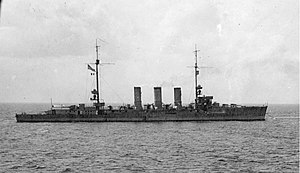 Wiesbaden's sister ship Frankfurt
| |
| History | |
|---|---|
| Name | SMS Wiesbaden |
| Namesake | Wiesbaden |
| Ordered | 29 June 1913 |
| Builder | A.G. Vulcan |
| Laid down | 10 November 1913 |
| Launched | 30 January 1915 |
| Commissioned | 23 August 1915 |
| Fate | Sunk at the Battle of Jutland, 1 June 1916 |
| General characteristics | |
| Class and type | Wiesbaden-class light cruiser |
| Displacement |
|
| Length | 145.30 m (476 ft 8 in) |
| Beam | 13.90 m (45 ft 7 in) |
| Draft | 5.76 m (18.9 ft) |
| Installed power |
|
| Propulsion |
|
| Speed | 27.5 knots (50.9 km/h; 31.6 mph) |
| Range | 4,800 nmi (8,900 km; 5,500 mi) at 12 knots (22 km/h; 14 mph) |
| Crew |
|
| Armament |
|
| Armor |
|
SMS Wiesbaden[a] was a light cruiser of the Wiesbaden class built for the Imperial German Navy (Kaiserliche Marine). She had one sister ship, SMS Frankfurt; the ships were very similar to the previous Karlsruhe-class cruisers. The ship was laid down in 1913, launched in January 1915, and completed by August 1915. Armed with eight 15 cm SK L/45 guns, Wiesbaden had a top speed of 27.5 knots (50.9 km/h; 31.6 mph) and displaced 6,601 t (6,497 long tons; 7,276 short tons) at full load.
Wiesbaden saw only one major action, the Battle of Jutland on 31 May – 1 June 1916. The ship was badly damaged by gunfire from the battlecruiser HMS Invincible. Immobilized between the two battle fleets, Wiesbaden became the center of a hard-fought action that saw the destruction of two British armored cruisers. Heavy fire from the British fleet prevented evacuation of the ship's crew. Wiesbaden remained afloat until the early hours of 1 June and sank sometime between 01:45 and 02:45. Only one crew member survived the sinking; the wreck was located by German Navy divers in 1983.
Cite error: There are <ref group=lower-alpha> tags or {{efn}} templates on this page, but the references will not show without a {{reflist|group=lower-alpha}} template or {{notelist}} template (see the help page).